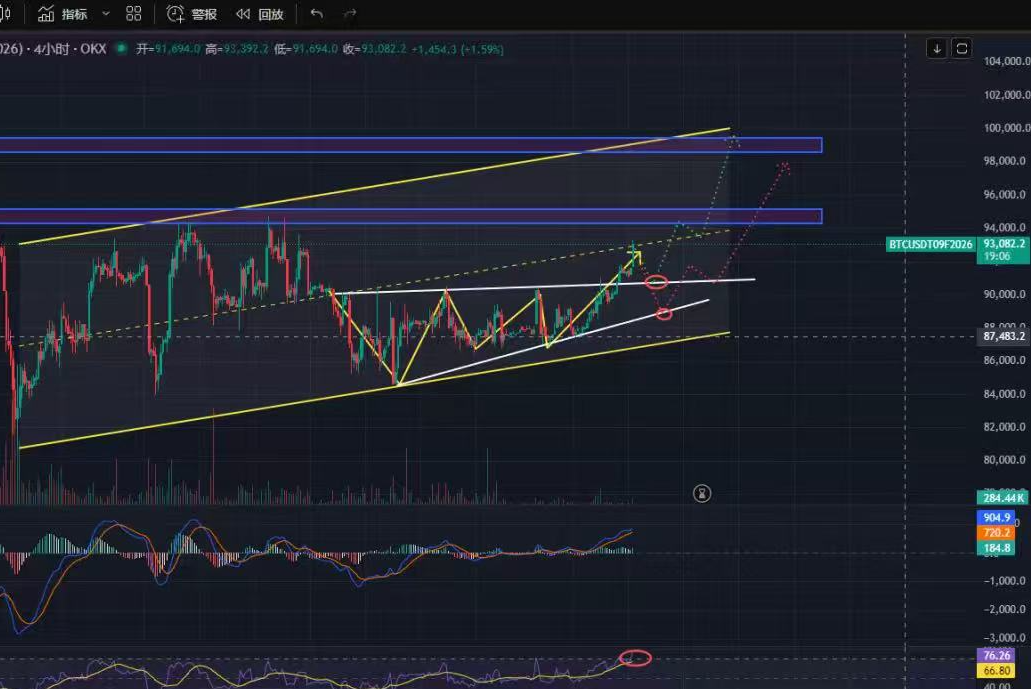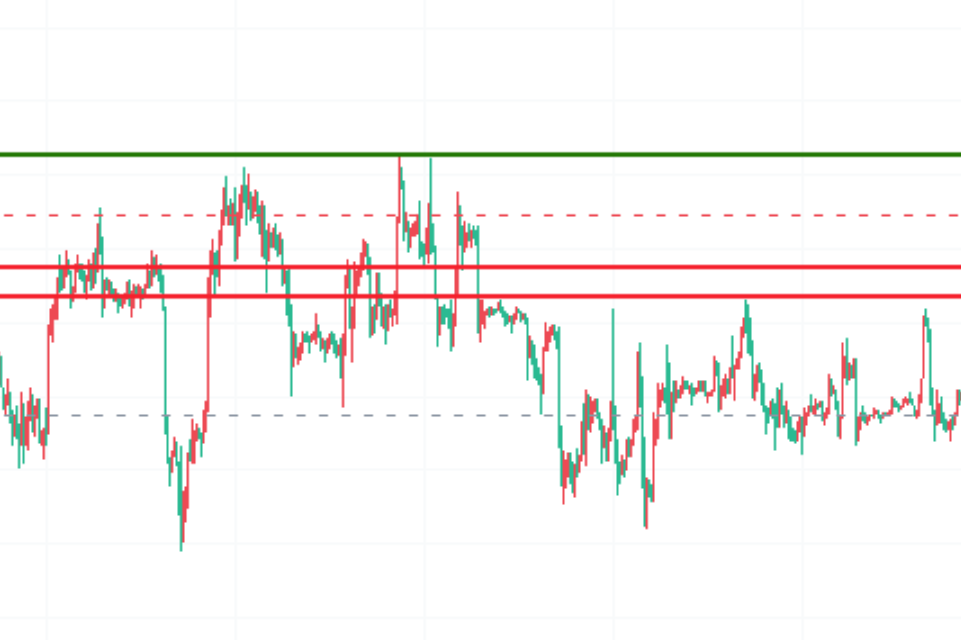This article uses two tools, moving averages and channels, combined with the impact of cycles to explain trends, oscillations, and order signals.
I. Trend
Trend refers to the direction in which the price is moving. When the trend has not reached its end, following the trend is the least risky method. However, even when following the trend, there may be pressure from oscillations and pullbacks, which could potentially lead to a reversal.
The daily, 4-hour, and 1-hour timeframes are defined as trend intervals, with the daily timeframe representing the long-term trend, the 4-hour representing the medium-term trend, and the 1-hour representing the short-term trend. If the 1-hour timeframe is unclear, refer to the 4-hour timeframe, and if the 4-hour timeframe is unclear, refer to the daily timeframe. The 4-hour timeframe is the most important trend interval, and its moving average can be considered as the boundary between long and short positions, holding significant importance. There are two implications:
Whether the candlestick breaks through the 4-hour moving average determines whether the trend will continue. The 4-hour moving average includes the 30-line and the 10-line, each with different implications. If it does not break through the 40-line moving average, the trend will have more time and space to develop. If it does not break through the 10-line moving average, the trend will still continue to develop, but with limited time and space, possibly indicating a "last gasp" with increased pullback risk, and it is highly likely to retest the 30-line moving average after further development. When the candlestick retraces to the 4-hour 10-line, in the 1-hour interval, it usually manifests as the candlestick retracing to the 30-line. The 12-line moving average of the daily timeframe also overlaps with the 30-line moving average of the 4-hour timeframe.
The starting point of the trend can be judged by the 30-line moving average, but the critical endpoint of a trend cannot be directly determined. Determining the critical endpoint requires the use of channels. When the candlestick effectively breaks through the 30-line moving average, select the two candlestick endpoints closest to the 30-line moving average as the starting point of the channel, forming the channel's starting point. The endpoint furthest from the moving average becomes the channel's terminal, forming the pattern of the trend's progression. The terminal of the channel will be the critical endpoint of the trend's progression. When the candlestick reaches this endpoint, it may retest the 10-line and 30-line in the opposite direction, or it may break through the channel's terminal to form a stronger trend. Therefore, the terminal of the channel does not necessarily have an absolute resistance effect.
As the trend develops, the angle of the channel needs to be adjusted accordingly. If the candlestick has not truly broken through both tracks of the channel and only has spikes, then the furthest spike point should be used as the new channel track point. If the candlestick breaks through the channel's terminal, the current trend ends, the channel becomes invalid, and the market enters an oscillation period.
Because the 4-hour timeframe's formation has a relatively long cycle for intraday operations, the 1-hour timeframe becomes an important reference for formation breakthroughs. When the candlestick approaches the channel's starting track or moving average based on the 4-hour timeframe, it is necessary to judge whether the trend is reversing or continuing. This involves waiting for a clearer candlestick to emerge in the 1-hour timeframe and then observing the signal before taking action.
II. Oscillation
There are two situations in which oscillation occurs: more real-time single strategies, online technical learning, and unwinding can be added to the mentorship. The top ten daily participants can receive unwinding strategies for free.
The first situation is oscillation before the formation of a trend, indicated by a strong breakthrough of the channel's starting track by the candlestick, signifying the end of the trend. After one trend ends, another trend will not immediately form, and it must go through an oscillation process. Therefore, it is not advisable to rush into taking positions in the opposite direction immediately after the trend ends. Instead, it is necessary to wait for the formation of an oscillation interval, otherwise, it may lead to repeated losses. The oscillation interval is usually a triangular or rectangular oscillation, where the candlestick will fluctuate back and forth within the oscillation interval until it strongly breaks through one end, forming a new trend.
The second situation is during the development of a trend, when the candlestick does not break through the channel's terminal and retraces to the channel's starting track. This will form a triangular oscillation. The prudent approach at this time is not to take positions and wait for the candlestick to break through the oscillation interval. If it breaks through in the direction of the trend, wait for a pullback before taking positions. If it breaks through in the opposite direction of the trend, it will enter another oscillation interval.
III. Signal
The signal is crucial for entry, and positions can only be taken when a signal appears. The signal timeframes are 1 hour, 30 minutes, 15 minutes, and 5 minutes. The signal appears when the candlestick enters the 60 moving average range of two signal timeframes (for example, the candlestick is above the 60 moving average in the 30-minute timeframe and below the 60 moving average in the 15-minute timeframe), and effectively breaks through any moving average in the direction of the candlestick's movement.
The timing for taking positions occurs within the signal interval, marked by the candlestick oscillating between the trend moving averages of the smaller and larger timeframes. The smaller timeframe is usually 5 minutes or 15 minutes, while the larger timeframe is 30 minutes or longer.
Positioning method: Maintain two types of patience,
Patiently wait for the appearance of the signal interval. It is not appropriate to chase after or take positions in the opposite direction without the appearance of the signal interval.
After the signal interval appears, patiently wait for the breakthrough. Do not take positions without a clear breakthrough, regardless of market fluctuations.
Clear breakthrough: The signal interval is composed of the 60 moving averages of two timeframes, so there are two directions for the breakthrough. For the smaller timeframe, there are three signals for a clear breakthrough: the candlestick's closing point in the smaller timeframe penetrates the long-term moving average to form a solid candlestick, the short-term moving average crosses the long-term moving average, and after penetrating the trend moving average, the candlestick must complete a retrace to the moving average, forming at least one reverse candlestick that penetrates the short-term moving average and touches the long-term moving average again, showing signs of a reversal. Only when all three signals appear can positions be taken in the direction of the breakthrough. When the candlestick retraces to the trend moving average and shows signs of a pullback, a position can be placed outside the previous high point.
For the larger timeframe, there are also two signals for a clear breakthrough: the candlestick must complete a retrace to the trend moving average in the smaller timeframe (5 minutes or 15 minutes) before penetrating the trend moving average in the larger timeframe, and the candlestick must penetrate the trend moving average in the larger timeframe. Both signals must appear simultaneously for positions to be taken in the direction of the breakthrough. After completing the retrace in the smaller timeframe, a position can be placed outside the trend moving average in the larger timeframe. The signal in the larger timeframe must be accompanied by the signal in the smaller timeframe to be effective!
Stop-loss setting: Set the stop-loss two points outside the moving average after the breakthrough. After a trend has developed, move the stop-loss, observe the candlestick in the smaller timeframe, and when the candlestick reverses for the first time, wait for the candlestick to pull up again before setting the stop-loss one point outside the lowest point of the reversal candlestick.
Take-profit setting: If there is resistance from the 1-hour, 4-hour, and daily moving averages in the direction of the candlestick's movement, use it as the take-profit point. If there are no moving average resistance points, use the channel's terminal as the take-profit point.
Follow the trend, avoid oscillation, take positions based on signals, and do not take positions if the channel's terminal is not broken.
I am Mr. Coin in the cryptocurrency circle! I publish market analysis and guidance at fixed times every day, and also provide real-time price calls from time to time! This team will be carefully created by Mr. Coin and more than 20 top analysts in the industry to provide free technical support and risk management for the contract community.
For more real-time single strategies, follow my public account to learn about real-time market technical analysis, unwinding, etc. I have studied the market for many years, analyzed major trends in the cryptocurrency circle, and have studied and guided the operations of BTC, ETH, DOT, LTC, FIL, EOS, BCH, ETC, and other cryptocurrencies. For those who are not familiar with operations, you are welcome to study and learn together with us.

免责声明:本文章仅代表作者个人观点,不代表本平台的立场和观点。本文章仅供信息分享,不构成对任何人的任何投资建议。用户与作者之间的任何争议,与本平台无关。如网页中刊载的文章或图片涉及侵权,请提供相关的权利证明和身份证明发送邮件到support@aicoin.com,本平台相关工作人员将会进行核查。




